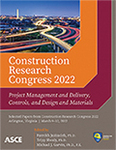Using Functional Near-Infrared Spectroscopy (fNIRS) to Evaluate the Construction Decision Making Inventory (CDMI)
Publication: Construction Research Congress 2022
ABSTRACT
Decision-making in the construction industry is extremely important as it impacts the safety, quality, time, and cost of the ever-increasing project complexity. Understanding an individual’s decision-making offers an opportunity to improve both learning and performance in the construction industry. To this effect, a psychometric instrument was developed named “Construction Decision Making Inventory (CDMI).” The CDMI characterizes an individual’s decision-making through a set of questions. This research study focuses on developing a framework to collect, analyze, and benchmark brain activities during the validation of the CDMI on measuring “How” individuals make decisions. The proposed framework is grounded on a mix-designed research methodology following the Human Subject Research protocol of two Texas universities. The framework includes measuring the brain activity of a group of participants while completing a face value validation of the CDMI. The framework includes: (1) Consent information, (2) Set-up of the functional near-infrared spectroscopy (fNIRS) to measure brain activity, (3) Stroop Test (Congruent and Incongruent), (4) Relaxation period, and (5) CDMI face value validation. The data collected from both the fNIRS and the CDMI face value validation instrument are then statistically correlated using a timestamp. Additionally, Rational-Experiential Inventory (REI) fNIRS data are included in the statistical correlation to validate the results. The results of this study are innovative and important as it provides the first insight into using fNIRS brain activity measurements to validate a psychometric instrument (such as the CDMI) to provide some light into “How” future construction professionals make decisions.
Get full access to this article
View all available purchase options and get full access to this chapter.
REFERENCES
An, M., Baker, C., and Zeng, J. (2005). A fuzzy-logic-based approach to qualitative risk modelling in the construction process. World J Eng, 2 (1), pp. 1–12.
Björklund, F., and Bäckström, M. (2008). Individual differences in processing styles: validity of the Rational–Experiential Inventory. Scandinavian journal of psychology, 49(5), 439–446.
Childs, B. (2015). Use of personality profile assessments in the construction industry. Brigham Young University, Provos, Utah. Retrieved from http://scholarsarchive.byu.edu/cgi/viewcontent.cgi?article=6633&context=etd (May 5, 2021).
Cox, W. M., Fadardi, J. S., and Pothos, E. M. (2006). The addiction-stroop test: Theoretical considerations and procedural recommendations. Psychological bulletin, 132(3), 443.
Delpy, D. T., and Cope, M. (1997). Quantification in tissue near–infrared spectroscopy. Philosophical Transactions of the Royal Society of London. Series B: Biological Sciences, 352(1354), 649–659.
Ekkekakis, P. (2009). Illuminating the black box: investigating prefrontal corticalhemodynamics during exercise with near-infrared spectroscopy. J. Sport Exerc. Psychol. 31 (4), 505–553.
Harper, C. M., and Sulbaran, T. (2019). Measuring the reliability of construction decision making inventory in construction management. Proc. of the 55th ASC Annual International Conference, April 10-13, Denver, CO, 663–670.
Hedden, T., and Gabrieli, J. D. (2004). Insights into the ageing mind: A view from cognitive neuroscience. Nature Reviews Neuroscience, 5, 87–96.
Homack, S., and Riccio, C. A. (2004). A meta-analysis of the sensitivity and specificity of the Stroop Color and Word Test with children. Archives of clinical Neuropsychology, 19(6), 725–743.
Kahneman, D., and Tversky, A. (2013). Choices, values, and frames. In Handbook of the fundamentals of financial decision making: Part I, 269–278.
Keaton, S. A. (2017). Rational‐Experiential Inventory‐40 (REI‐40) (Pacini & Epstein, 1999). The Sourcebook of Listening Research: Methodology and Measures, 530–536.
Lloyd-Fox, S., Blasi, A., and Elwell, C. E. (2010). Illuminating the developing brain: thepast, present and future of functional near infrared spectroscopy. Neurosci. Biobehav. Rev. 34 (3), 269–284, https://doi.org/10.1016/j.neubiorev.2009.07.008.
Nguyen, L., Rosicki, S., Rowe, C., and Schoenberger, H. (2015). The effects of cell phone distractions on cognitive flexibility. Journal of Advanced Student Sciences.
Pacini, R., and Epstein, S. (1999). The relation of rational and experiential information processing styles to personality, basic beliefs, and the ratio-bias phenomenon. Journal of personality and social psychology, 76(6), 972.
Renaud, P., and Blondin, J. P. (1997). The stress of Stroop performance: Physiological and emotional responses to color–word interference, task pacing, and pacing speed. International Journal of Psychophysiology, 27(2), 87–97.
Salthouse, T. A. (2009). When does age cognitive decline begin? Neurobiological Aging, 30, 507–514.
Sulbaran, T. (2017). Introduction of the construction decision making inventory 9CDMI) to improve educational experience. Proc. Of the 2017 ASEE Gulf-Southwest Section Annual Conference, The University of Texas at Dallas.
Thompson-Schill, S. L., Aguirre, G. K., D’Esposito, M., and Farah, M. J. (1999). A neural basis for category and modality specificity of semantic knowledge. Neuropsychologia, 37, 671–676.
Verhaeghen, P. (2003). Aging and vocabulary scores: A meta-analysis. Psychology and Aging, 18, 332–339.
Wang, Y., and Ruhe, G. (2007). The cognitive process of decision making. International Journal of Cognitive Informatics and Natural Intelligence, 1(2), 73–85. https://doi.org/10.4018/jcini.2007040105.
Zhai, J., and Barreto, A. (2006, August). Stress detection in computer users based on digital signal processing of noninvasive physiological variables. In 2006 international conference of the IEEE engineering in medicine and biology society (pp. 1355–1358). IEEE.
Information & Authors
Information
Published In
History
Published online: Mar 7, 2022
Authors
Metrics & Citations
Metrics
Citations
Download citation
If you have the appropriate software installed, you can download article citation data to the citation manager of your choice. Simply select your manager software from the list below and click Download.
